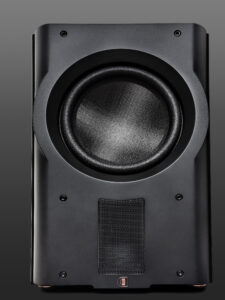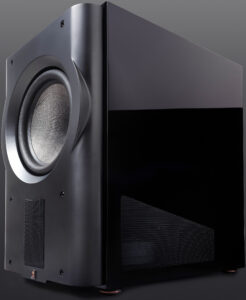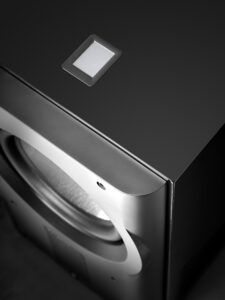For those trying to avoid larger floor standing speakers, perhaps a better solution would be to buy the S5m Monitors, which would capture the lion’s share of performance without blowing your budget. I will head off questions asking me whether the S7t is worth more money over the S5m, as I have not done the actual comparison. No one, short of Perlisten, can answer that question if they have not done the comparison. Be wary of authorities who presume to make declarations about diminishing returns when they haven’t bothered to do comparisons. Such comments usually arise from — I will be polite here — thriftiness versus a desire to seek ultimate performance, perhaps at significantly higher cost. Diminishing returns is one of the favorite phrases of budget audiophiles who wish to obtain extreme performance at very little cost. They habitually judge equipment as regards sound quality without ever hearing it because of an a priori commitment to the budget. Trust me, I know the mentality, as I was a budget audiophile for many years.
In every instance I have used a company’s bookshelf speaker in comparison to its tower speaker having the same build DNA I have never felt the bookshelf was so good or performed so closely that it would be the better choice excepting space or budget limitations. Whether you opt for the bookshelf or the floorstander, try your best to integrate at least one Perlisten sub, especially as they are exquisite at optimizing to the room.
The D212s is representative of the overengineered and overbuilt subwoofers Perlisten makes. I was thrilled to see a 3-kilowatt amplifier in this subwoofer. In system building I have found consistently that clean, high power means cleaner music with superior dynamics.
A key advantage to the D series of subwoofers is that they are brainy, which makes them phenomenally flexible as additions to a system. I do mean phenomenally flexible, as they literally have a computer system onboard; their configurability exceeds the norm. Along with that flexibility is an intuitive, uncluttered software remote app that allows full access and adjustments for the couch potato listener. More importantly, it allows real time comparisons as adjustments are made. Kudos for the ability to link both subs so that general adjustments do not need to be duplicated. However, PEQ settings are done individually by necessity, as room anomalies may dictate particular settings for each sub.
Another powerful advantage is the push-pull design of the D212s. Whereas the Legacy XTREME XD subs have two 15” woofers facing out at right angles in a sealed enclosure, the powered one rearward and the passive one facing down, the D212s reverses that order with the powered 12” driver facing forward and the bottom one facing inward. Importantly, it is not a sealed design, but has the bottom driver reinforcing the forward driver. There are no passive radiators; rather both 12” drivers are powered. I wasn’t told but I presume the inward firing bottom driver supports the forward one.
I do not wish to overstate the benefit of this particular feature as there are other important differences between these two subs, such as a power differential of thousands of watts! The bottom line, however, is that the Perlisten sub is massively more powerful. It is more forceful, clean and has zero perceived overhang, which makes it sound impossibly fast. That is, even at full throttle it is so perfectly in line with the excursion of the 7” drivers that one cannot detect its presence unless the output is set to a ridiculously high level skewing the LF output. This would be the sub to use with dipole speakers, as I did with the Kingsound King III electrostatic speakers. Don’t guffaw at that comment; the D212s is so linear it makes me wonder if its measurements could be more linear than the ESL speaker. A goodly portion of the community will be skeptical. As uninformed digital music listeners mistakenly think there is not a lot of difference between DACs, uninformed subwoofer fans don’t think there is a lot of difference between subs. You’re wrong. I recommend a Perlisten subwoofer demo to rearrange your perspective.
The D212s has the ability not only to be blended at a crossover point, as is the case with most subwoofers, but also to mitigate issues affecting room integration, and that makes this subwoofer worth the price tag. When the S7t was being integrated into my room there was a strong room mode centered at about 50Hz. It had the effect of making the speaker system seem lighter in the mid-bass than normal. But Dan and Erik, through room analysis, were able to adjust the PEQ settings of the D212s to address this effectively. Consequently, the entire presentation was enhanced most noticeably by more consistent bass output throughout the lower end. The upshot was that notes in the 50Hz range that would fall back and soften were shored up such that they were less shy. Dan and Erik have done so much listening to their products that they needed only one track to assess the bass output —Boz Skaggs’s “Thanks to You” on the album Dig. They called it out, then measured and found they had called it right. I was duly impressed. I was also impressed that manipulation of a subwoofer could rework the speaker system’s sound to ameliorate a significant room anomaly.
There are differing degrees of seamlessness when it comes to integrating subwoofers. That sounds wrong, just as it might seem wrong to state that there can be differing degrees of black backgrounds in audio systems. I’m not interested in debate on either of these matters. In terms of seamlessness, the Perlisten duo is far more seamless than most. I have spent a decade integrating the fine Legacy Audio XTREME XD subwoofers with all manner of genres and brands of mains, and apart from using the Legacy Audio Wavelet, the Legacy subs simply do not have the brains to integrate as well as the D212s. That is not a criticism of Legacy, as the subs were designed properly to complement Legacy products. I attest that when used with the Wavelet processor/DAC/preamp/room correction component, recalling from memory, I would say the XTREME XD blended as well with the big Legacy speakers as the Perlisten subwoofers to the S7t. But the D212s offer a more elegant system for integrating subwoofers to different brands and genres of main speakers.
The variance in performance is quite noticeable when one moves to use of a heterogenous setup of subs and mains. The XTREME XD apart from the Wavelet (note: Legacy would advise use of the Wavelet with the subwoofers) does not offer independent room correction capabilities, nor the degree of refinement in blending. By putting the brains into the subwoofer, Perlisten has streamlined the integration and room correction process and made it more appealing to the audiophile to hunt for whatever mains they wish, and to do so with confidence that a very high-end result will occur. In terms of system development, the audiophile would need to choose practically between the all-in-one solution of the Wavelet and XTREME XD, as it includes preamp and DAC functionality, and the Perlisten brainy sub solution, which would offer more flexibility in selection of components.
How they sound
The most prominent impressions I have of the Perlisten setup is that it is super-clean and super-deep. Being super-clean is not in reference to a segment of the frequency spectrum, as the D212s is extraordinarily fine, nearly absurdly detailed. I have always demanded much refinement from the bass and LF, and the D212s open a new vista to systems with such bass.
A speaker system’s cleanness with detail retrieval dictates the character of the soundstage, period. With higher detail retrieval comes more queues to the spatial relationships between artists and the spatial characteristics of the recording venue. Those who are seeking to eliminate some degree of resolution in an audio system adversely influence the soundstage. Perlisten must be blending the tiny midrange drivers into the mid-bass drivers in order to get the warmth necessary for reasonable vocals. A carbon fiber coating is not going to make a 1” driver sound large and generous. Evidently the carbon fiber process used by Perlisten can result in more resolution. However the drivers are blended, voices are thrillingly intimate and not lacking in color. The S7t is more resolving than the Vapor Audio Joule White with its 6” Accuton, and also less strident. I approve of the tightrope walking the S7t does in offering radical resolution and tonal warmth.
Pieces I am playing recently to assess vocals include Sarah Bareilles’s “Satellite Call.” I pay attention to both the kick drum whacks at the outset of the song and the ascending “Ooooo” crooning. One can wander into a world of fun manipulating the bass with the D212s to get the kick drum to sound just so. The output and low pass filter, which can be configured from 30-160Hz, offer a myriad of options. Tweakers will find delight in manipulating all this from their seat and being able to assuredly hear the result. Even as I step the output up or down by .5dB, I can follow the influence of the adjustment in real time. That is a huge benefit of the brainy sub schema of Perlisten. As one manipulates and hears the watercolor blending of all these settings, just how much perception is personalized is striking. There won’t be any universal perfect sound coming soon. Rather, personalized sound with ultimate convenience is happening with Perlisten.
When the subs are so well mated — blended — the extended frequency response results in a speaker system that is so capable that even ridiculously difficult musical genres are reproduced with aplomb. LF-heavy music is a breeze and typical bass playing by artists like Brian Bromberg and Marcus Miller are a romp. The solidity and ripeness of their playing, especially with electric bass, is most gratifying. Likewise the intimacy, as this speaker system reveals the fingering of the instrument with deftness.
A new favorite bass player is Charles Berthoud, a younger artist with giftedness spread across various bass instruments, who plays “Bass Solo in 10 Different Styles.” It is the kind of performance I would use as a demo track at audio shows for assessing bass performance, and it’s fun to hear. I see on YouTube that he has an update, “Bass Solo in 15 Styles.” Watch that video and imagine a speaker system that brings it to a true-to-live performance. I have imagined a Perlisten experience. I do almost nothing with my 100” home theater screen but play a DVD movie every few months. But the combination of his playing and the Perlisten setup could motivate me to link the HT to the network to show him playing over the sound system.
At the other end of the spectrum, one of my torture tracks for treble is Alison Moyet’s “Invisible”. Has there ever been a more dastardly, irritatingly treble-infused pop song? At least with the S7t the metallic noises are identifiable as a reverberating tambourine. Most of the time it sounds like the sound of a drawer of silverware crashing on the floor played on a loop.
Lindsey Stirling’s aggressive violin can get edgy, but not with the DPC-Array. Her violin floats like a butterfly but does not sting like a bee. Importantly, with the D212s, the inordinately strong LF line is fully rendered without stress and with full fidelity. As a test of the diminutive midrange drivers, I considered Eve St. Jones’s voice as she sang “Space Cowboy.” One might think from the appearance of the little midrange drivers that warmth would be hard found, but not so. The S7t plays just on the warm side of neutral, and Eve’s wispy voice is infused with enough color that she doesn’t sound like she is whispering while singing.
Quiet emotive pieces are glorious with the pristinely precise DPC-Array. Very few pieces of music move me to tears, but the intimacy and heartfelt character of Joy Williams’ “Welcome Home” is overpowering. The Perlisten system proves that a high caliber performance is not all about force and extremes, but about nuances drawn from a measured rendition. Also moving was David Phelps’ version of the plaintive prayer “Bring Him Home” from Les Miserables. He reaches high notes with power and restraint, both characteristics displayed superbly by the S7t and D212s.
For the better part of twenty years, I have derided the notion that there exists The One, the ultimate speaker, much less the ultimate genre of speaker. As I grow to love the Landscape Orientation experience, I cannot help but admire deeply the work of Perlisten in capturing the ineffable elements of sound that I have been chasing. If I had to give up my other speakers (I do not), I would probably go after the S7t as The One. It has upper end sensibilities while reframing the sound stage in many ways that are truer to life than the common portrait orientation of most tower speakers. If it were not for the appealing particularities of dipole electrostatics, omnis, and full range dynamic and coaxial speakers, I could settle on the S7t as The One. I am unwilling to sacrifice all those other experiences to have only one. I’m not ready yet to sacrifice variety for it, and in that respect I am an outlier. For you, the equation for system building is likely different. The Perlisten S7t and D212s is likely a bona fide fantastic-performing system with unique sound dispersion. It may fill a niche that you don’t even know exists.
Not off-the-shelf audio
It can be a tenuous affair to buy a product from a new manufacturer. Twice I have been disappointed in buying from manufacturers with stunning products, but who were not able to make the transition into an established company. In both cases the companies were essentially a solo effort, that is, mostly dependent upon a solitary jack-of-all-trades individual. While Perlisten is new, it obviously has some serious financial backing and a deeply experienced team. Having five principal members versus one is not a guarantee of future success, but does lend robustness to the endeavor in terms of knowledge base, experience in the industry, and money. So far it appears Perlisten is making a solid reputation for itself.
A novel design can be a very good thing, as I am hearing the Landscape Orientation as applied to the Perlisten DPC-Array sounding more engaging than the bulk of moderately sized towers I have used, and the subs are simply in an altogether different category than the dumb subs on the market. Will the company be here five years from now? I have no idea, as the fickle nature of the world economy and supply chains have been disrupted so as to require being remade. Don’t get me started on that.
Perlisten is off to a very good start and its products are evocative of the likes of the aforementioned Magico, YG Acoustics, Rockport, and Gamut —so far without a nosebleed price tag. Given what I hear from the S7t and D212s, that won’t be the case for long. The S7t is a good buy, and the D212s is a steal. As I explained earlier, the subwoofers are the game changer for all systems I build with competitor speakers of a variety of genres, so they are staying. If I did not have a commitment to spreading the wealth among several genres of speakers, the S7t would stay, too.
What if you cannot afford the upper line of Perlisten products? Consider the D15s or D12s subwoofers and speakers from the R Series. Presuming the same care in design and construction is found in them and based on my experience with the character of the products under review, I would expect highly commendable performance.
Copy editor: Dan Rubin
NEXT: Perlisten Inteview (coming soon)
ANCILLARY COMPONENTS
Source: Small Green Computer sonicTransporter and SONORE Signature Rendu SE with systemOptique
USB Cable: Clarity Cable Supernatural 1m
DACs: COS Engineering D1 DAC + Pre-Amplifier; Exogal Comet with PLUS Power Supply and Ion PowerDAC; Eastern Electric Minimax Tube DAC Supreme with Staccato Discrete Opamps
Iconoclast Generation 2 XLR and RCA OCC Interconnects
Y-Cables: Audio Sensibility silver OFC XLR and RCA
Amplifiers: Legacy Audio i.V4 Ultra Amplifier (2); Kinki Studio EX-M1+ Integrated Amplifier; Redgum Audio Articulata Integrated Amplifier
Speaker Cables: Version 1 Iconoclast TPSPC Speaker Cables and Version 2 Speaker Cables; Iconoclast Version 1 and Version 2 28” Jumper Cables (for close amp placement to the speakers’ binding posts)
Speakers: Legacy Audio Whisper DSW Clarity Edition; Kingsound King III electrostatic; PureAudioProject Trio15 10” Coaxial; PureAudioProject Quintet15 Horn1; Aspen Acoustics Lagrange L1; Kingsound King Tower omnidirectional; Wharfedale Opus 2-M2 Bookshelf; Ohm Walsh Model F
- ← Previous page
- (Page 2 of 2)



